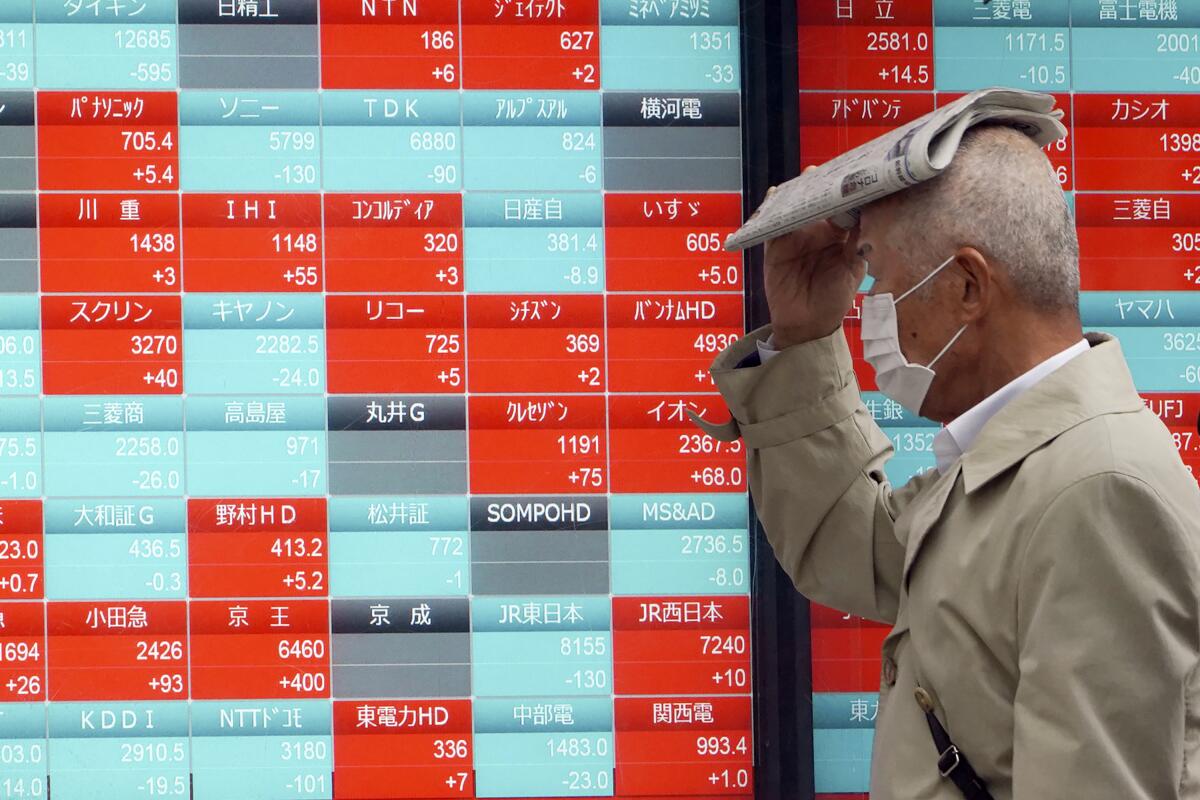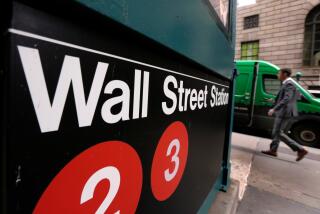U.S. futures, world markets sink as virus crisis deepens

- Share via
BEIJING — U.S. futures slipped more than 3% on Monday and share benchmarks in many world markets logged sharp losses as governments tightened restrictions to fight the coronavirus pandemic.
Stocks fell in Paris, London and Frankfurt, Germany, after a brutal session in Asia on Monday.
Japan’s Nikkei 225 index was the outlier, gaining 2.0% after the International Olympic Committee and Japanese officials indicated they are considering postponing the Tokyo Games, due to begin in July.
India’s Sensex plummeted 11.3% after a sharp drop on the open triggered a circuit breaker halt to trading. Singapore’s benchmark plunged 7.8% after the city-state announced a sharp increase in confirmed infections and its first two deaths.
Shares also fell nearly 8% in Bangkok, Thailand.
Japan’s Prime Minister Shinzo Abe acknowledged that a postponement of the 2020 Tokyo Games could be unavoidable as Canada and Australia added to the immense pressure that has been mounting on organizers by saying they wouldn’t send athletes to Tokyo unless the Olympics are postponed for a year.
The latest updates from our reporters in California and around the world
In the U.S., top-level negotiations between Congress and the White House continued after the Senate voted against advancing a nearly $2-trillion economic rescue package. Another vote was expected Monday.
The Democrats said the bill was tilted too much toward aiding corporations and would not do enough to help individuals and healthcare providers weather the crisis brought on by the pandemic.
By 4:45 a.m. EDT, the S&P 500 future contract was down 3.4% at 2,209.70. The future for the Dow dropped 3.6% to 18,351.00.
Germany’s DAX lost 3.8% to 8,580.56 and Britain’s FTSE 100 tumbled 4.1% to 4,976.54. In Paris, the CAC 40 shed 2.8% to 3,935.15.
Markets reopened to an altered business landscape Monday as lockdowns and closures intended to halt the spread of the new coronavirus expanded over the weekend to include many cities around the world and the number of people infected surged past 336,000.
“Risk aversion appears here to stay as investors become more fearful that this could be the worst global recession during peacetime,” Edward Moya of Oanda said in a commentary.
“Every passing day it seems lockdown efforts are intensified globally thus it seems financial markets will remain nervous until we see the infection rate improve in both the U.S. and Europe,” Moya said.
Sydney’s S&P/ASX 200 fell 5.6% to 4,546.00 after plunging more than 8% sharply just after the open. Australia announced a $38.5-billion stimulus package on Sunday. That’s in addition to an earlier mandated $10-billion package and other stimulus from the central bank.
South Korea’s Kospi lost 5.3% to 1,482.46. Hong Kong’s Hang Seng index shed 4.9%, to 21,696.13, while the Shanghai Composite index slipped 3.1% to 2,660.17.
The Nikkei was at 16,887.78.
Shares also fell in Taiwan and Southeast Asia.
Stocks fell sharply on Wall Street and the price of oil sank again Friday as New York became the latest state to decide that nearly all workers should stay home to limit the spread of the coronavirus. California and several other states in the U.S. and a growing number of countries have also imposed limits on business activity.
The S&P 500 lost 4.3% to 2,304.92 on Friday while the Dow skidded 4.6% to 19,173.98. The Nasdaq composite index lost 3.8% to 6,879.52.
This week will bring fresh data that are likely to underscore the damage to Asian economies from the outbreak of the virus that originated in China.
A sharp surge in cases and in deaths across the region, especially in Southeast Asia, have also raised the level of alarm.
Shutdowns mean less demand for oil. U.S. crude has dropped about 21%, dipping below $20 a barrel last week for the first time since February 2002. However, on Monday benchmark crude was up 8 cents at $22.71 per barrel in electronic trading on the New York Mercantile Exchange.
Brent crude, the international standard, dropped 99 cents to $25.99 per barrel.
Ultimately, investors say they need to see the number of new infections stop accelerating for the market to end its prolonged, bouncing tumble to lows not seen for a decade.
The S&P 500, the benchmark for many index funds held in retirement accounts and the measure preferred by professional investors, is down 31.1% since reaching a record high a month ago. Last week marked its biggest weekly loss since October 2008 during the global financial crisis.
Investors have continued to seek safety in U.S. government bonds, driving their yields broadly lower. The 10-year Treasury yield, which influences interest rates on mortgages and other consumer loans, slid to 0.79% Monday from 0.94% late Friday.
At nearly $2 trillion, the U.S. rescue package is the biggest effort yet to aid households and shore up the U.S. economy, the world’s biggest.
But markets have continued to fall as scores of other governments and many central banks have acted as they try to stave off or at least alleviate the impact of a recession.
Many investors are waiting for markets to fall further before plunging back in, said Naeem Aslam of Avatrade.
Should the market drop by another 10% to 20%, the overall decline from recent peaks would be over 50%, and “that would be a massive buy signal,” Aslam said.
Meanwhile, demand for the U.S. dollar has been soaring. The dollar was at 110.10 Japanese yen on Monday, down from 110.83 yen late Friday.
The euro fell to $1.0651 from $1.0697.
More than 14,400 people have died of the coronavirus worldwide, while nearly 100,000 people have recovered.
For most people, the coronavirus causes only mild or moderate symptoms, such as fever and cough, and those with mild illness recover in about two weeks. Severe illness including pneumonia can occur, especially in the elderly and people with existing health problems, and recovery could take six weeks in such cases.
More to Read
Inside the business of entertainment
The Wide Shot brings you news, analysis and insights on everything from streaming wars to production — and what it all means for the future.
You may occasionally receive promotional content from the Los Angeles Times.









